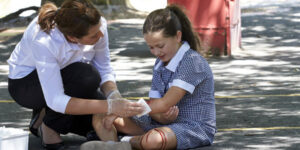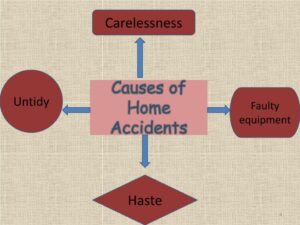Back to: Religion and National Values Primary 2
Welcome to class!
In today’s class, we’re going to be talking about Meaning of accident in school and home. I trust you will enjoy the class!
Meaning of Accident in School and Home

– An accident is an unexpected event that causes danger, harm, or damage.
– Accidents can happen anywhere, but they are more common in places where people spend a lot of time, such as school and home.
– Accidents can cause injury, pain, sickness, or even death to the people involved.
– Accidents can also damage or destroy the things around us, such as books, toys, furniture, or buildings⁴.
Examples of accidents in school and home

– Some of the common examples of accidents in school and home are:
– Falls: This is when someone slips, trips, or loses balance and falls to the ground. Falls can happen on stairs, slippery floors, wet grass, or uneven surfaces. Falls can cause bruises, cuts, sprains, fractures, or head injuries.
– Cuts: This is when someone gets wounded by a sharp object, such as a knife, a blade, a pin, a needle, or a broken glass. Cuts can happen when someone is using, playing, or handling these objects carelessly. Cuts can cause bleeding, pain, infection, or scarring.
– Electric shocks: This is when someone gets a sudden jolt of electricity from a source, such as a naked wire, a socket, a switch, or an appliance. Electric shocks can happen when someone touches, plugs, or switches these sources without proper care or protection. Electric shocks can cause burns, spasms, unconsciousness, or cardiac arrest.
– Burns: This is when someone gets injured by a hot object, such as an iron, a kettle, a stove, or a fire. Burns can happen when someone is using, cooking, or heating these objects without proper care or protection. Burns can cause blisters, pain, swelling, or scarring.
Causes of accidents in school and home

– Some of the common causes of accidents in school and home are:
– Carelessness: This is when someone does not pay attention or act responsibly in what they are doing. Carelessness can lead to accidents such as falls, cuts, electric shocks, or burns. For example, running on the stairs, playing with knives, touching naked wires, or leaving hot objects unattended.
– Ignorance: This is when someone does not know or understand the dangers or risks of what they are doing. Ignorance can lead to accidents such as falls, cuts, electric shocks, or burns. For example, not knowing how to use the stairs, not knowing how to handle sharp objects, not knowing how to avoid electric sources, or not knowing how to deal with hot objects.
– Curiosity: This is when someone wants to explore or learn new things without proper guidance or supervision. Curiosity can lead to accidents such as falls, cuts, electric shocks, or burns. For example, wanting to see what is on the top shelf, wanting to see what is inside a box, wanting to see what happens when they plug something, or wanting to see what happens when they light something.
Prevention of accidents in school and home
– Some of the common ways to prevent accidents in school and home are:
– Be careful: This is when someone pays attention and acts responsibly in what they are doing. Being careful can prevent accidents such as falls, cuts, electric shocks, or burns. For example, walking on the stairs, using sharp objects with caution, avoiding electric sources, or handling hot objects with care.
– Be informed: This is when someone knows and understands the dangers or risks of what they are doing. Being informed can prevent accidents such as falls, cuts, electric shocks, or burns. For example, learning how to use the stairs, learning how to handle sharp objects, learning how to avoid electric sources, or learning how to deal with hot objects.
– Be supervised: This is when someone has a parent, a teacher, or an adult to guide or watch over them in what they are doing. Being supervised can prevent accidents such as falls, cuts, electric shocks, or burns. For example, having someone to help them reach the top shelf, having someone to check the box, having someone to plug the appliance, or having someone to light the fire.
Conclusion
– An accident is an unexpected event that causes danger, harm, or damage.
– Accidents can happen in school and home, and they can cause injury, pain, sickness, or death to the people involved, or damage or destroy the things around them.
– Accidents can be caused by carelessness, ignorance, or curiosity, and they can be prevented by being careful, being informed, or being supervised.
